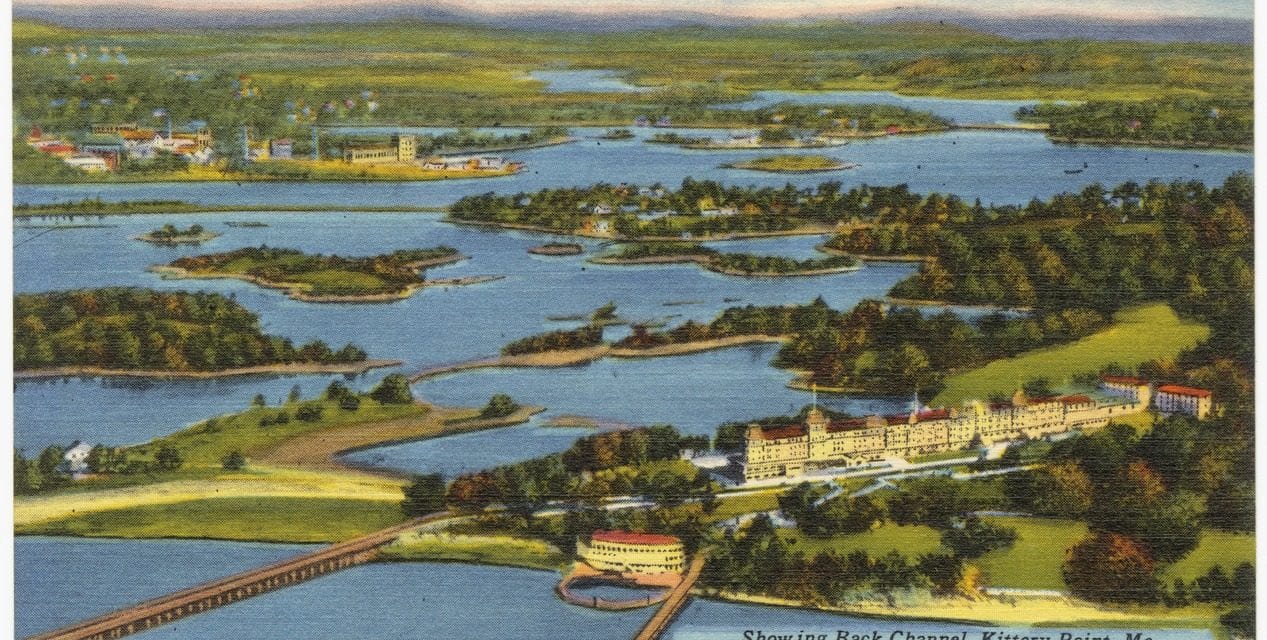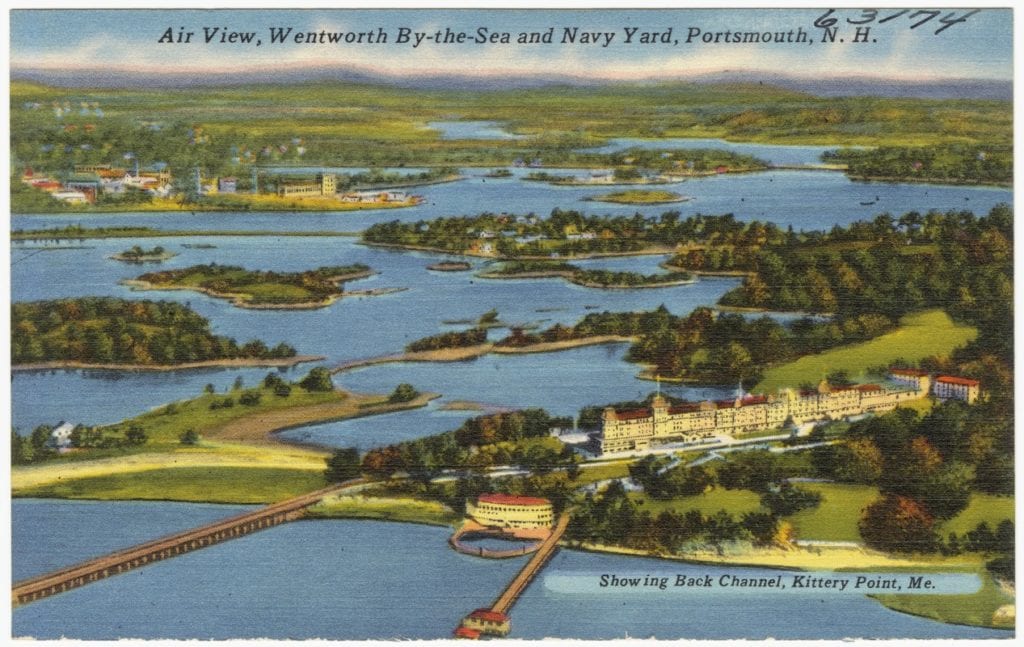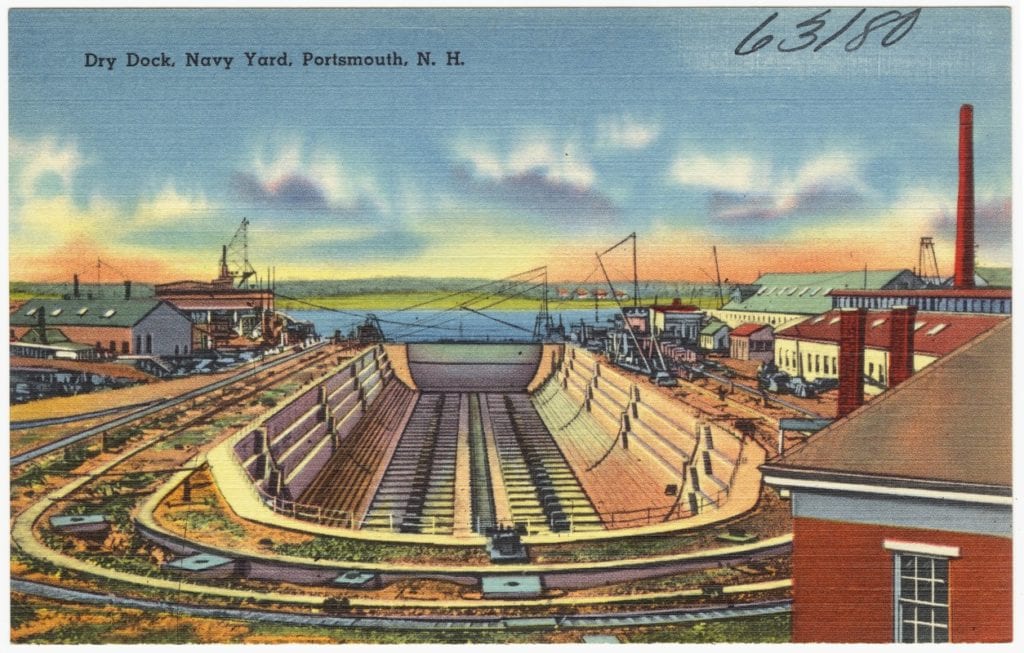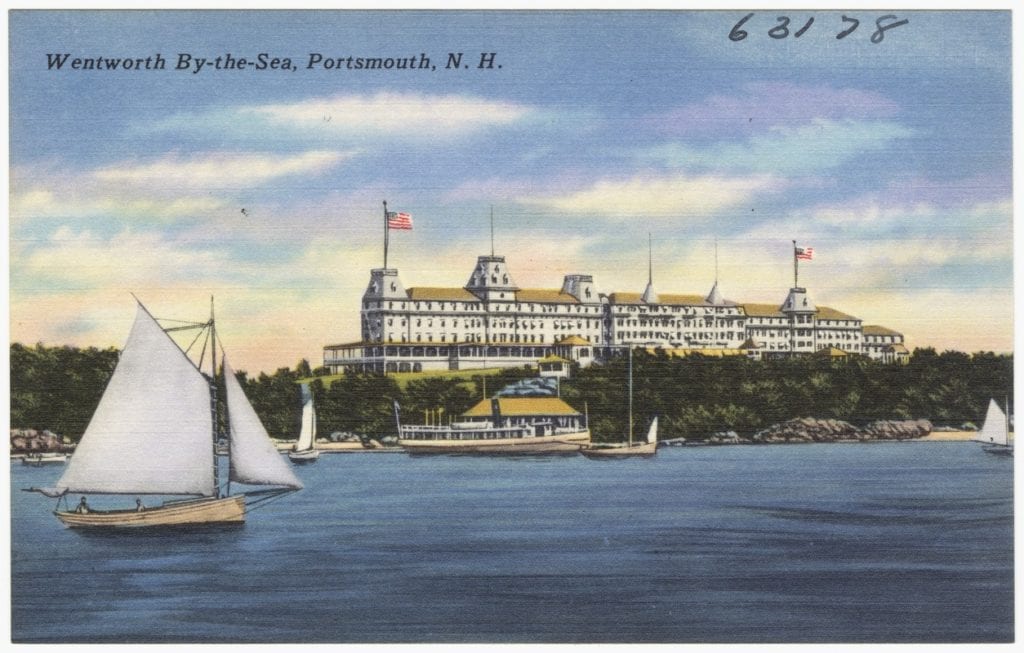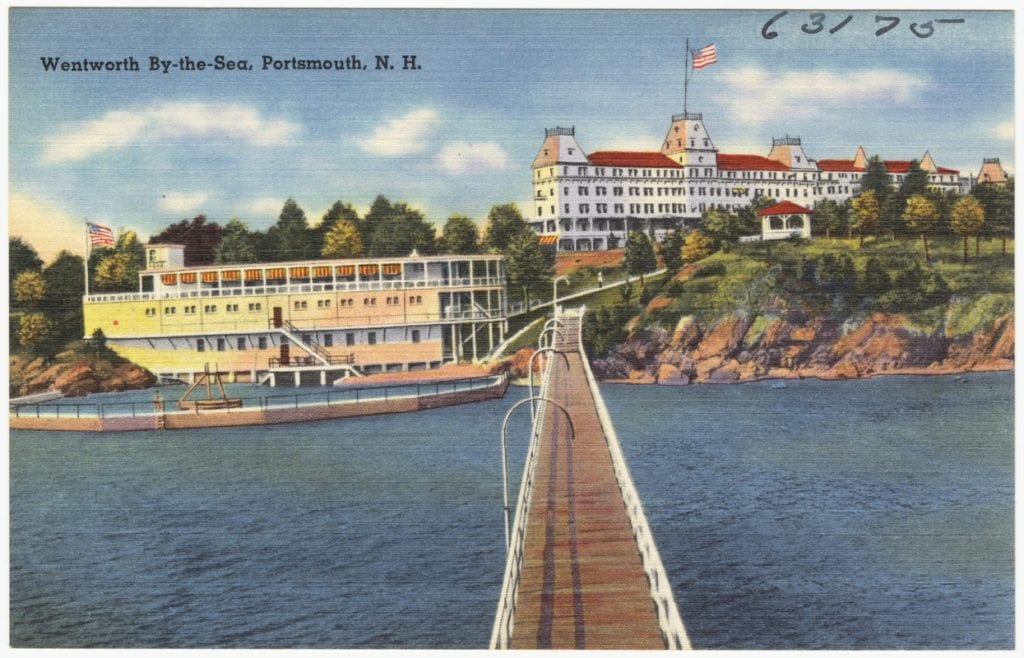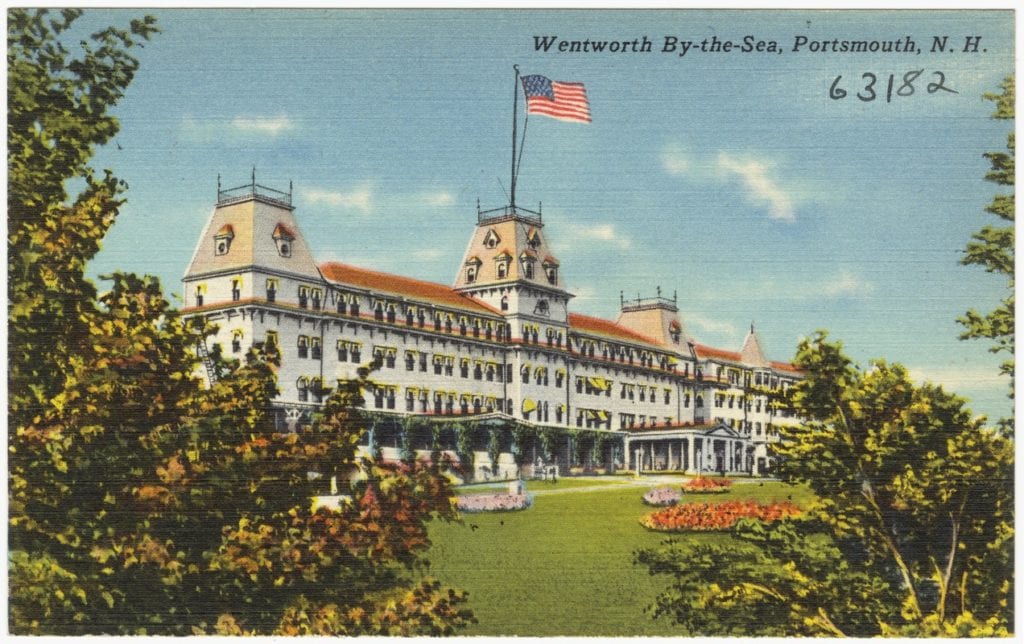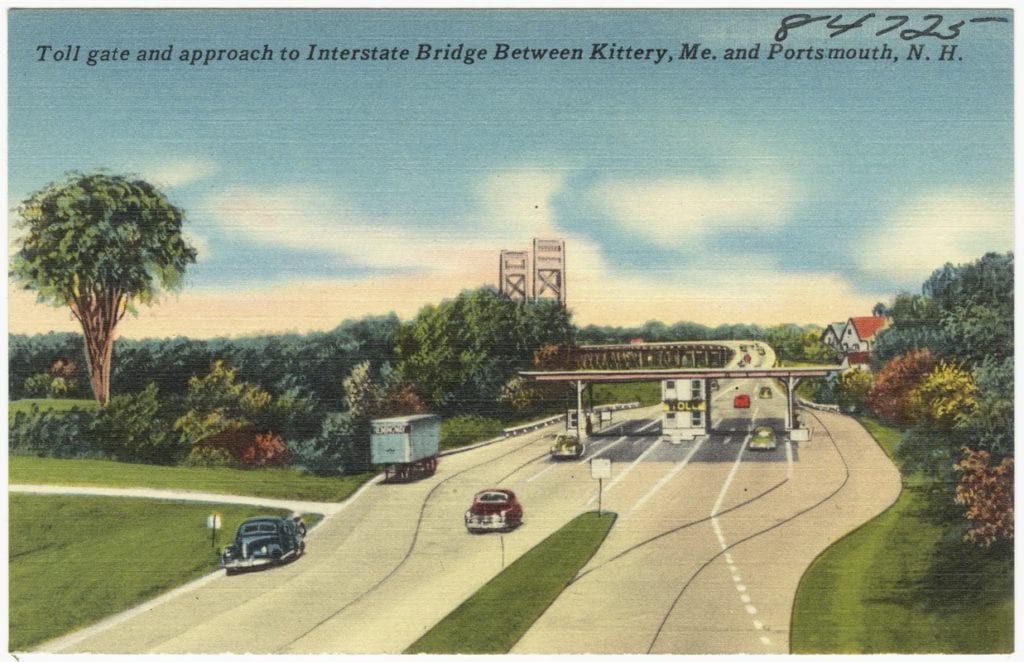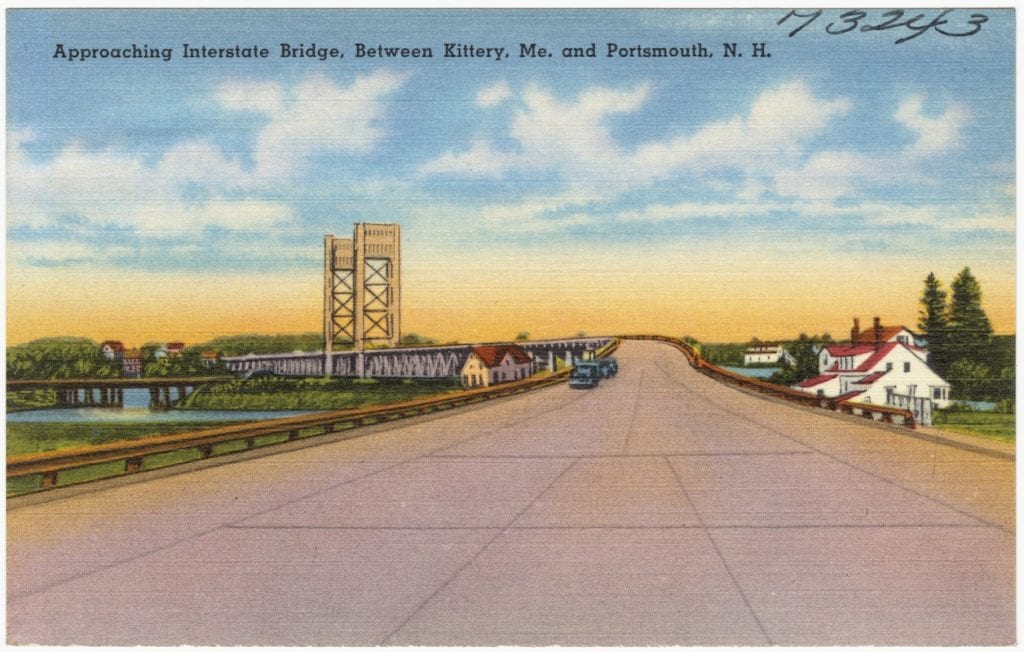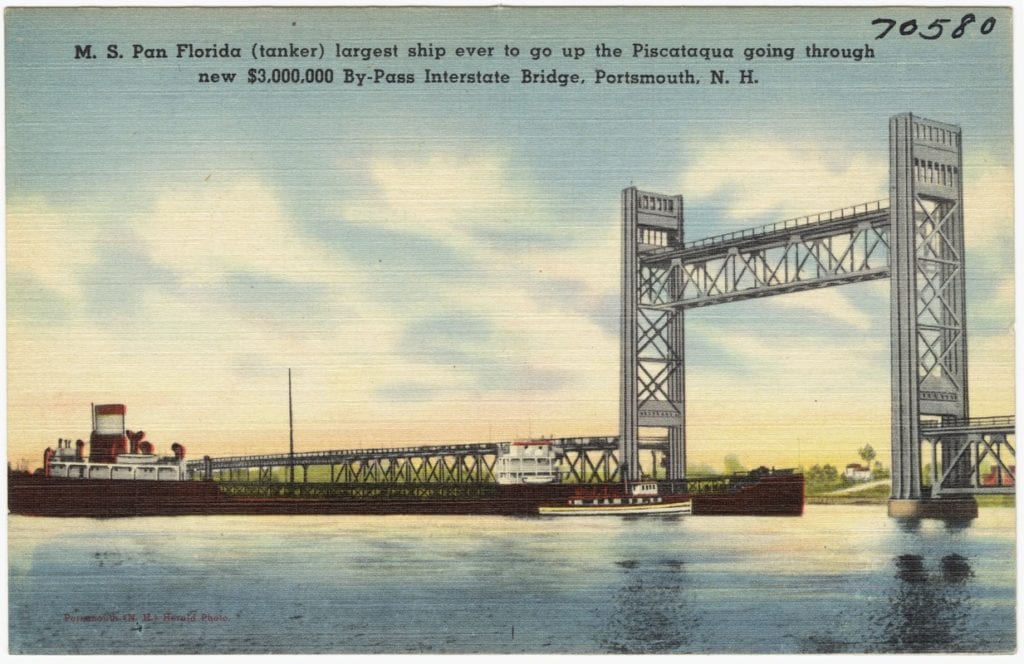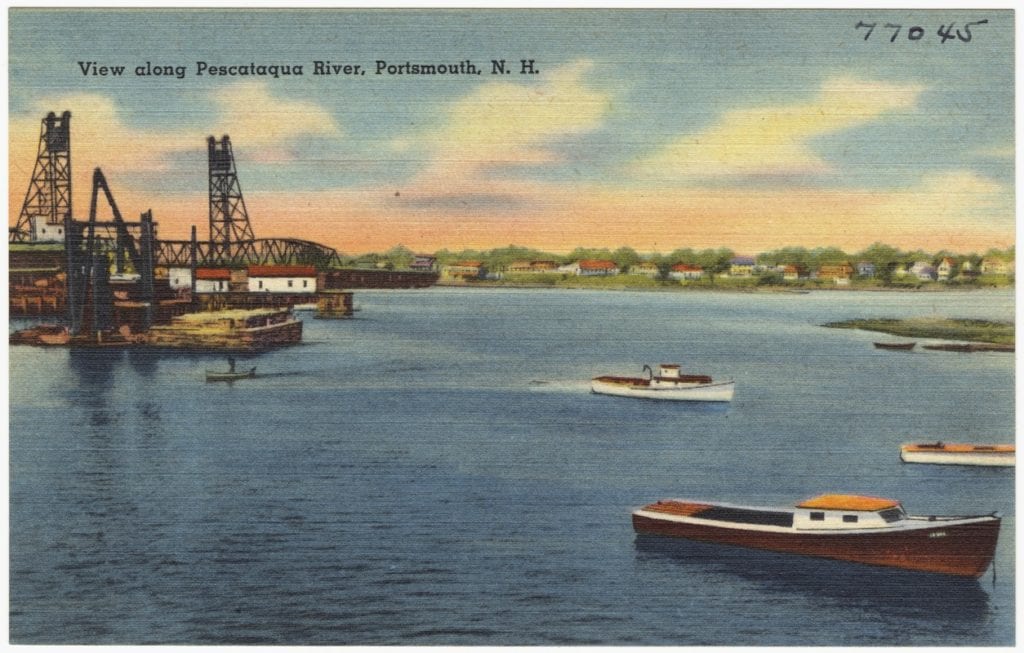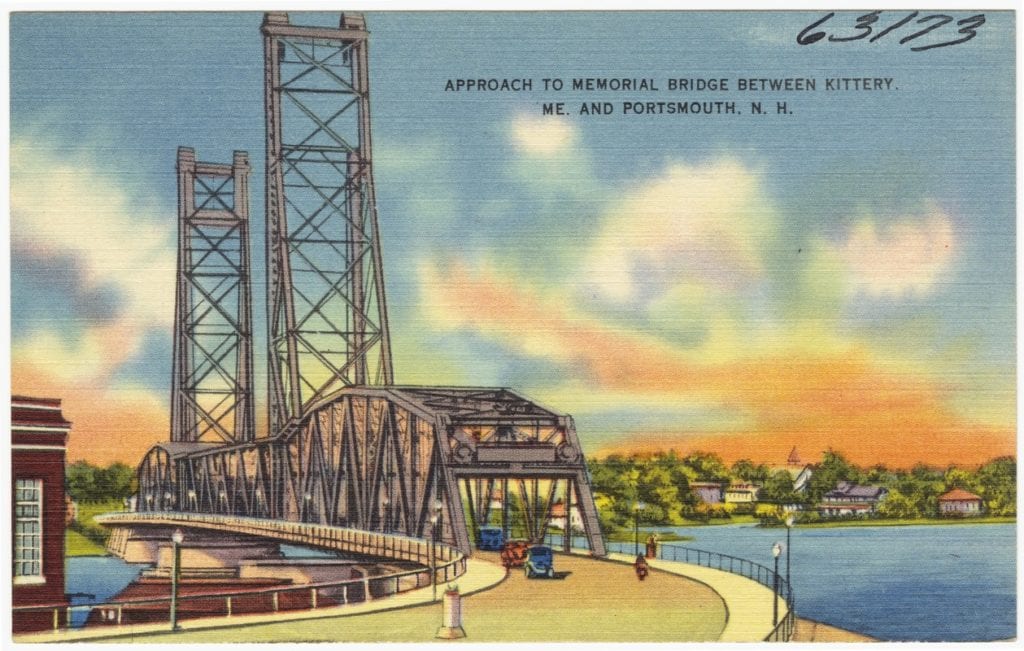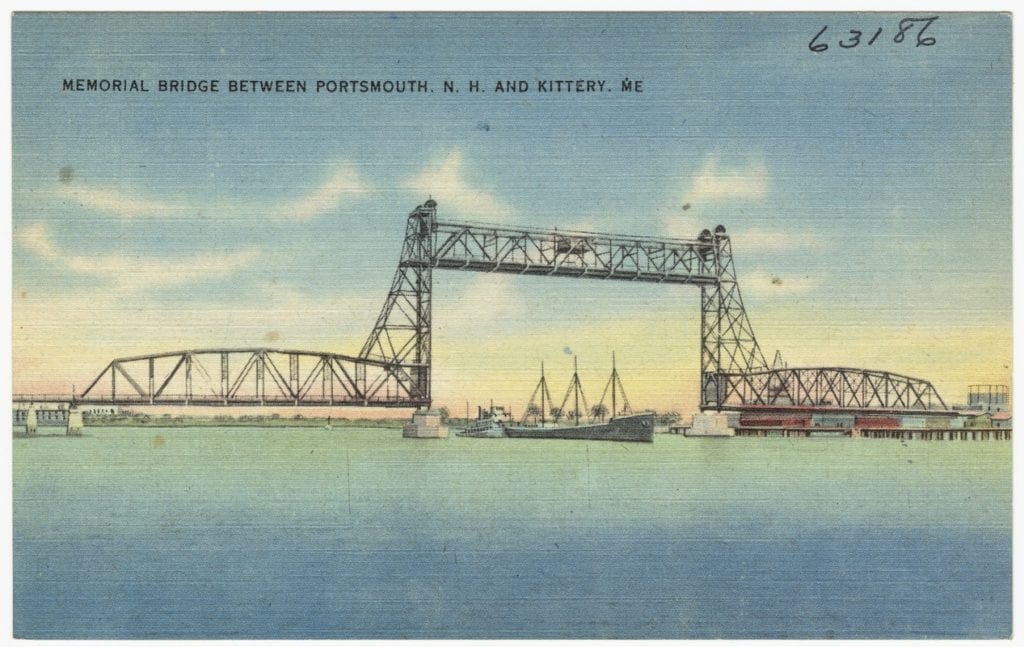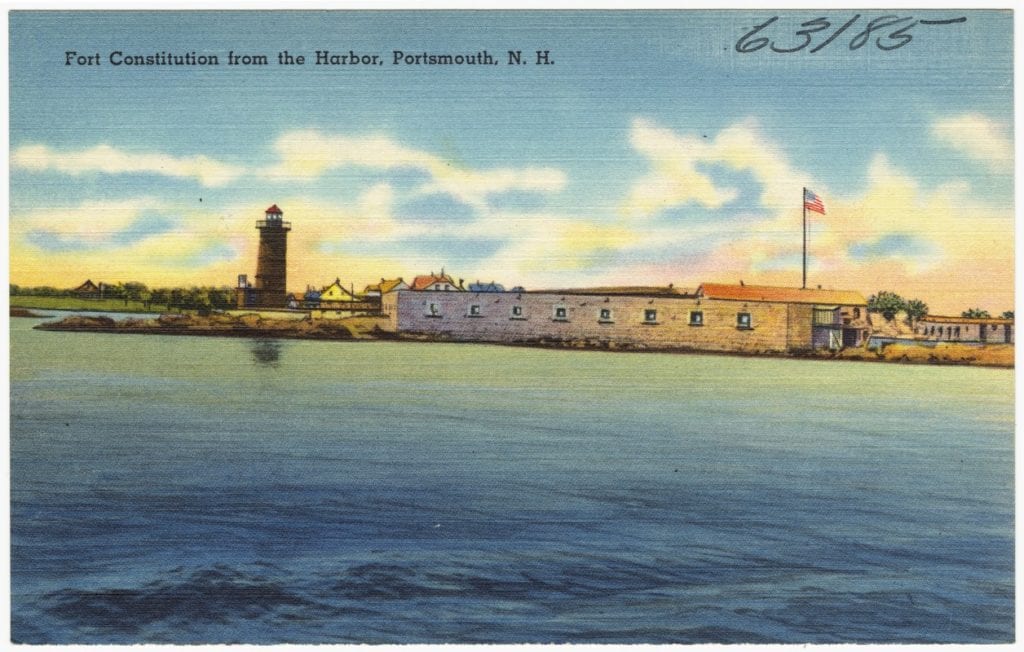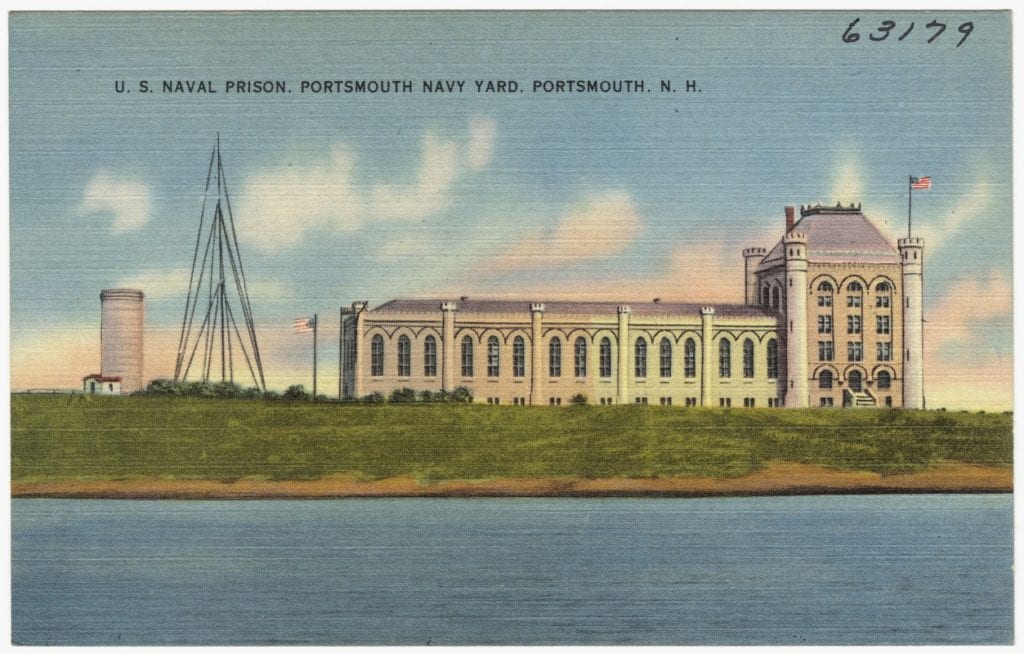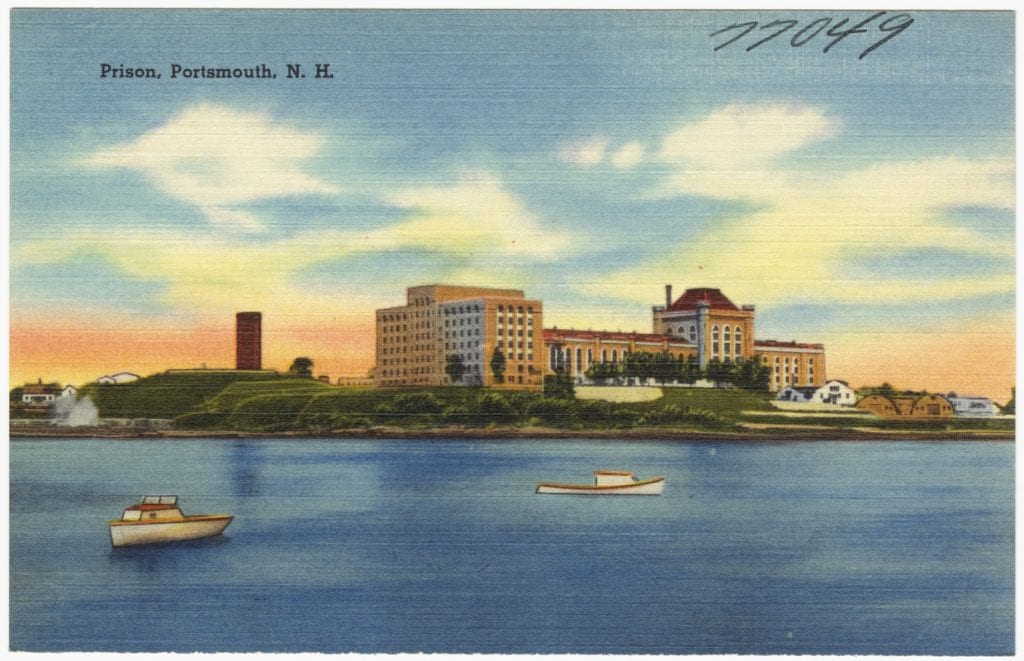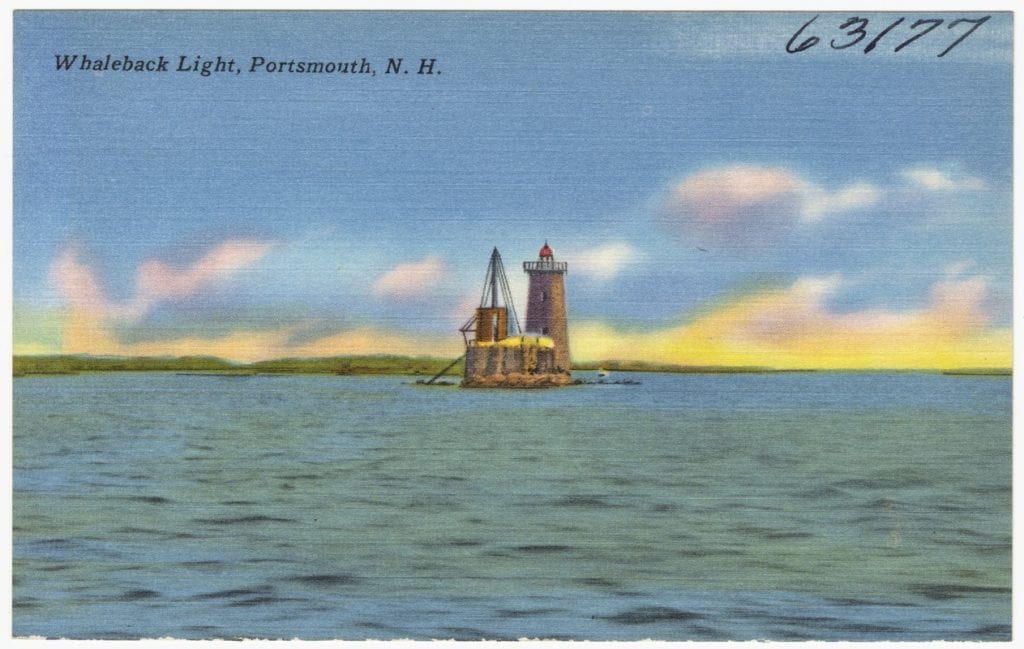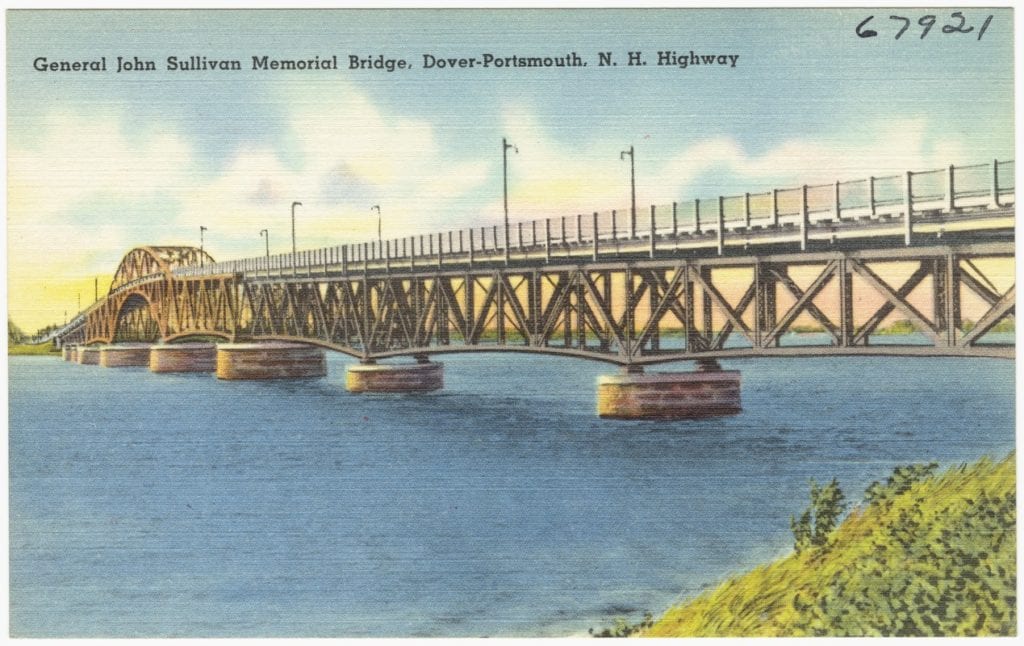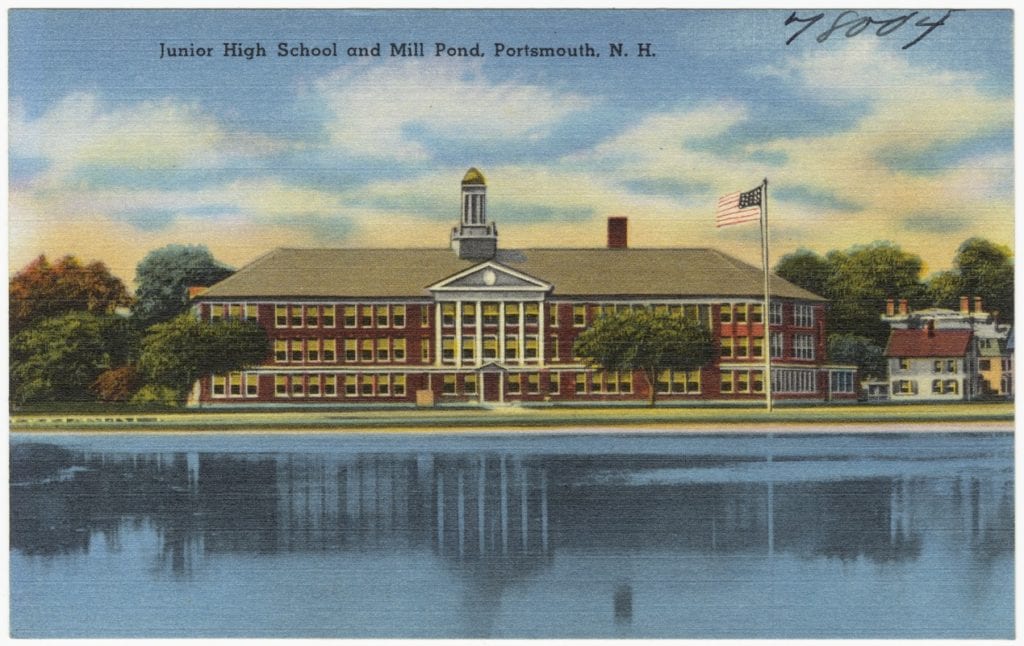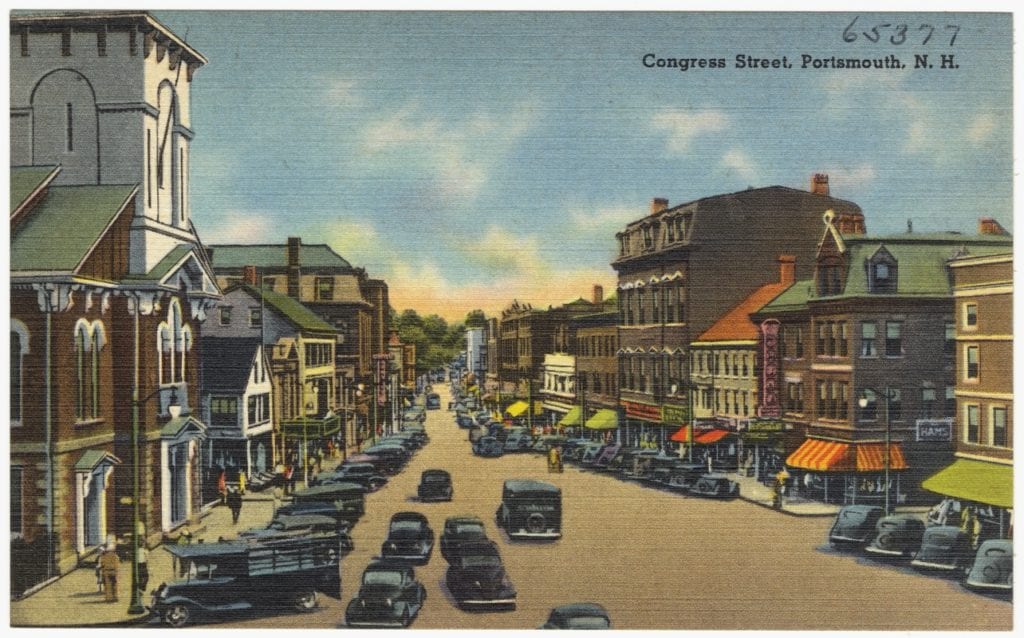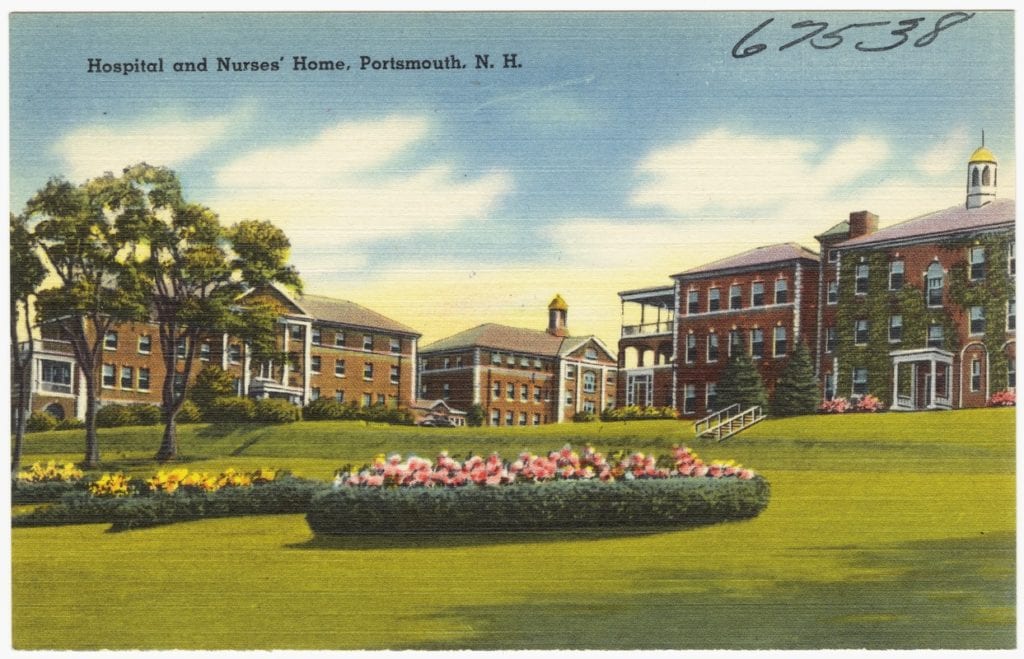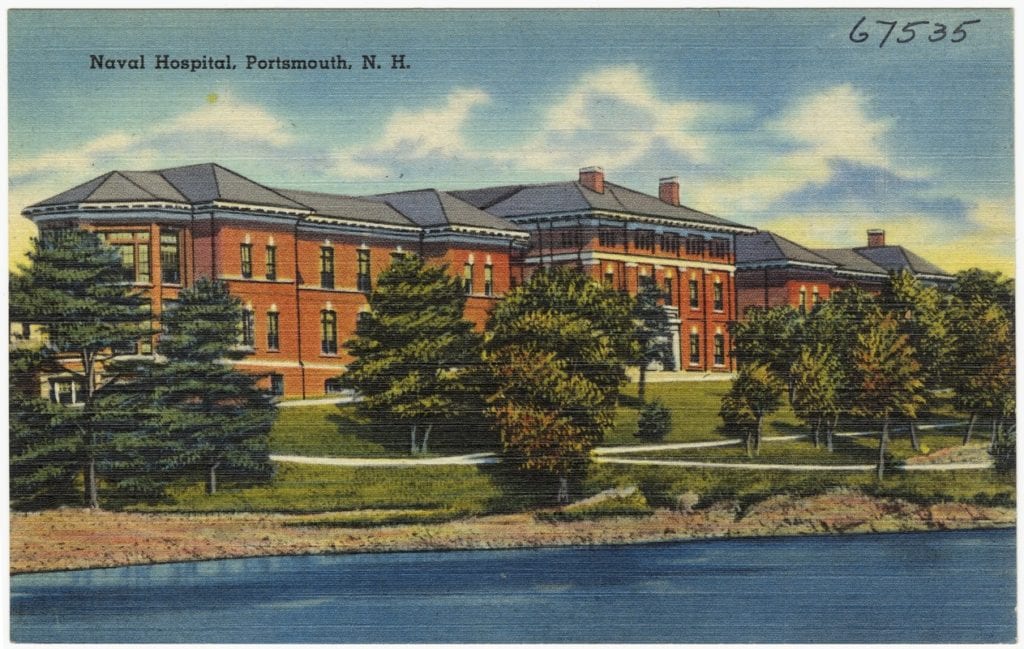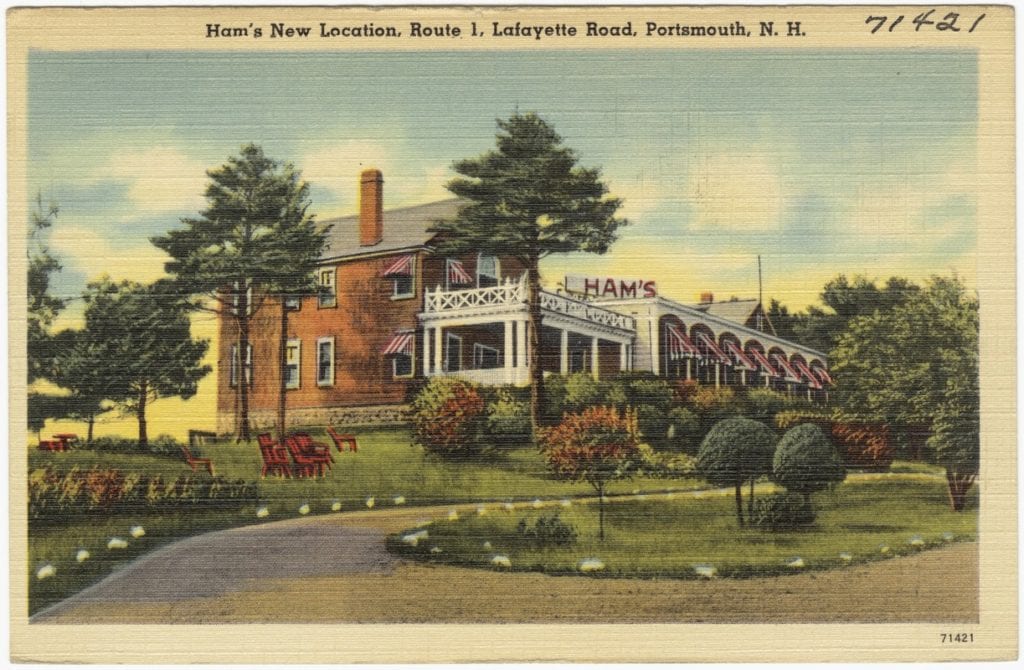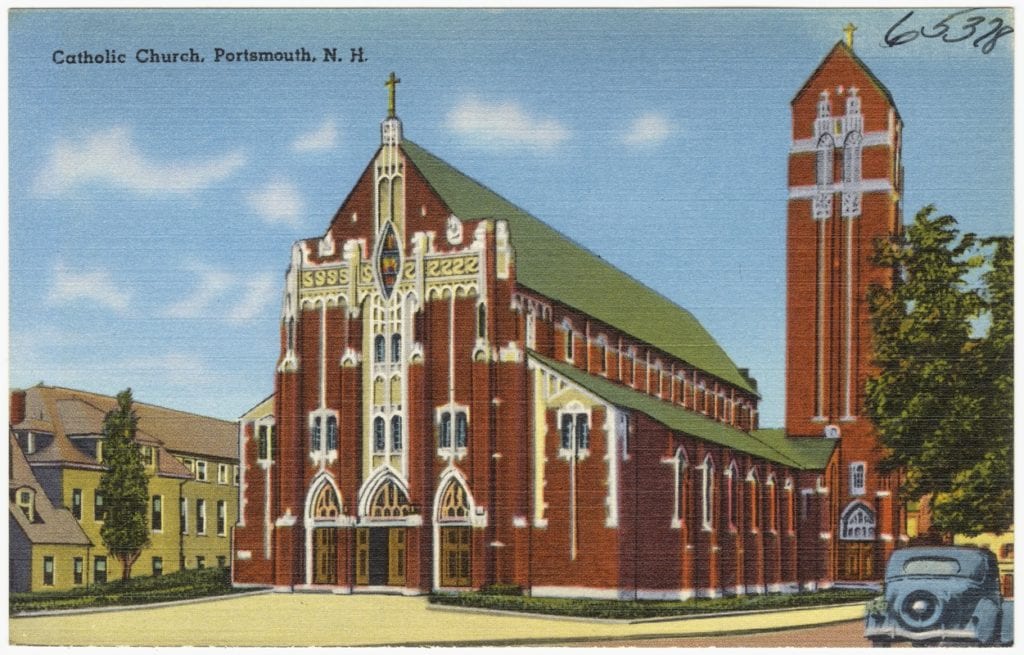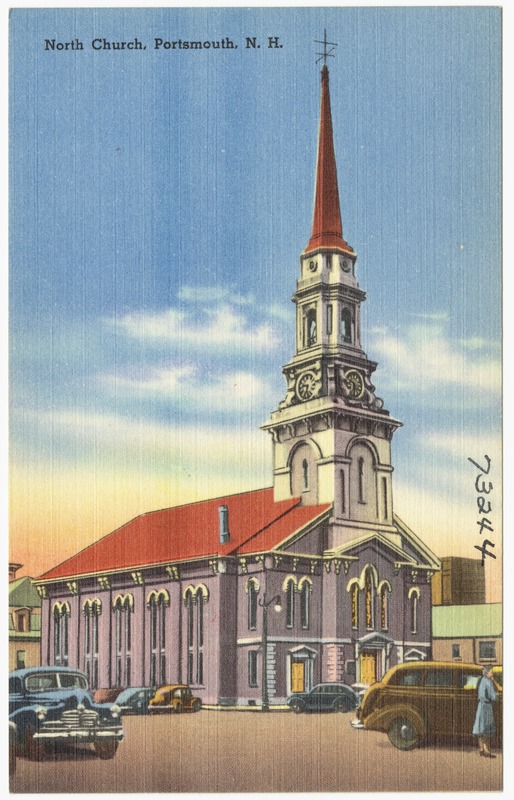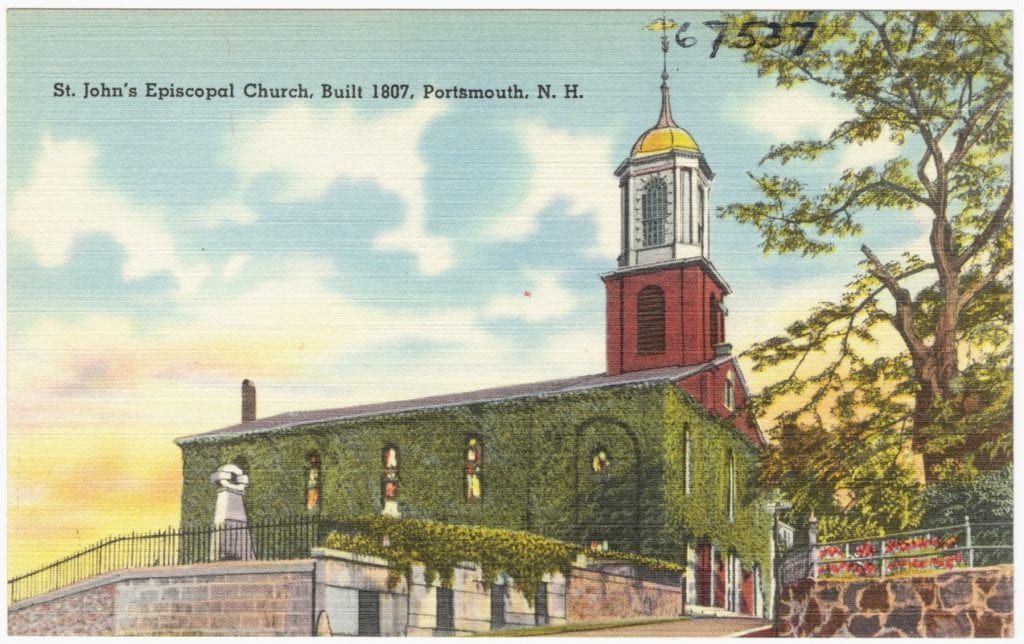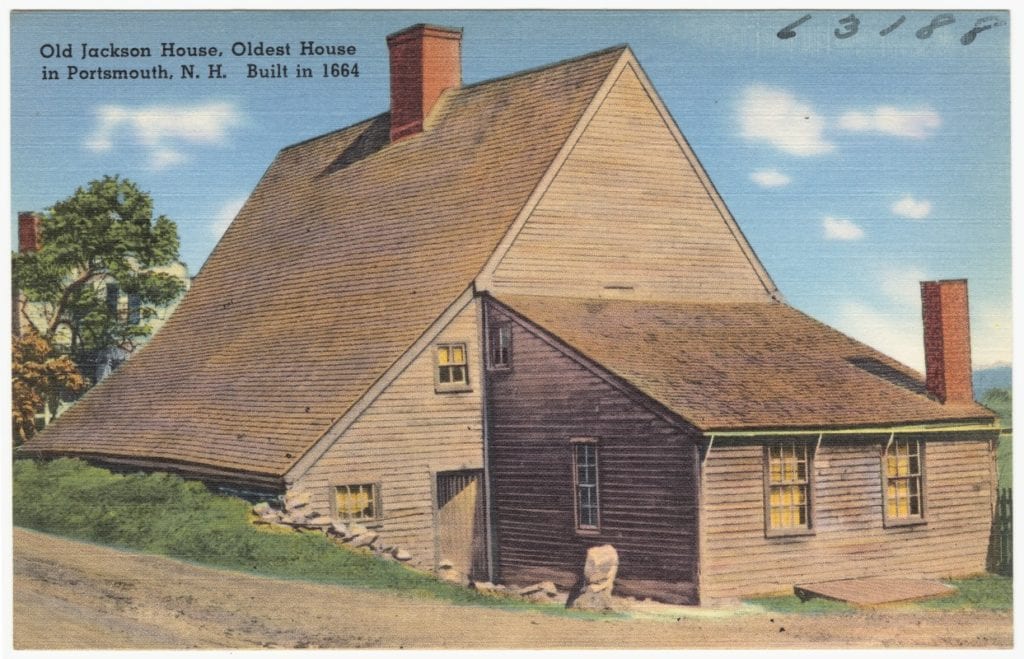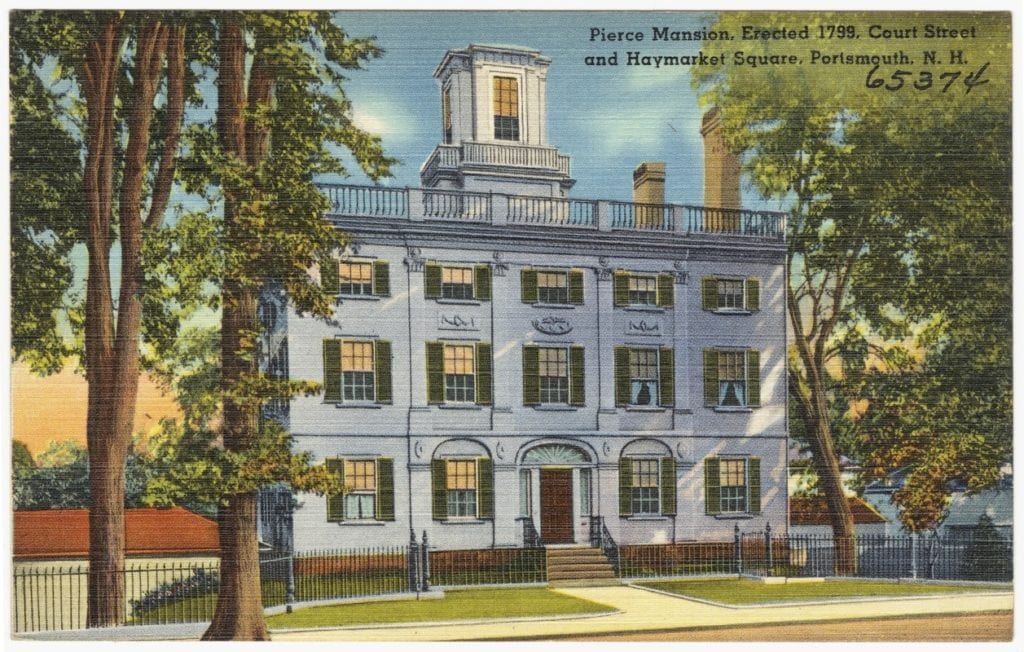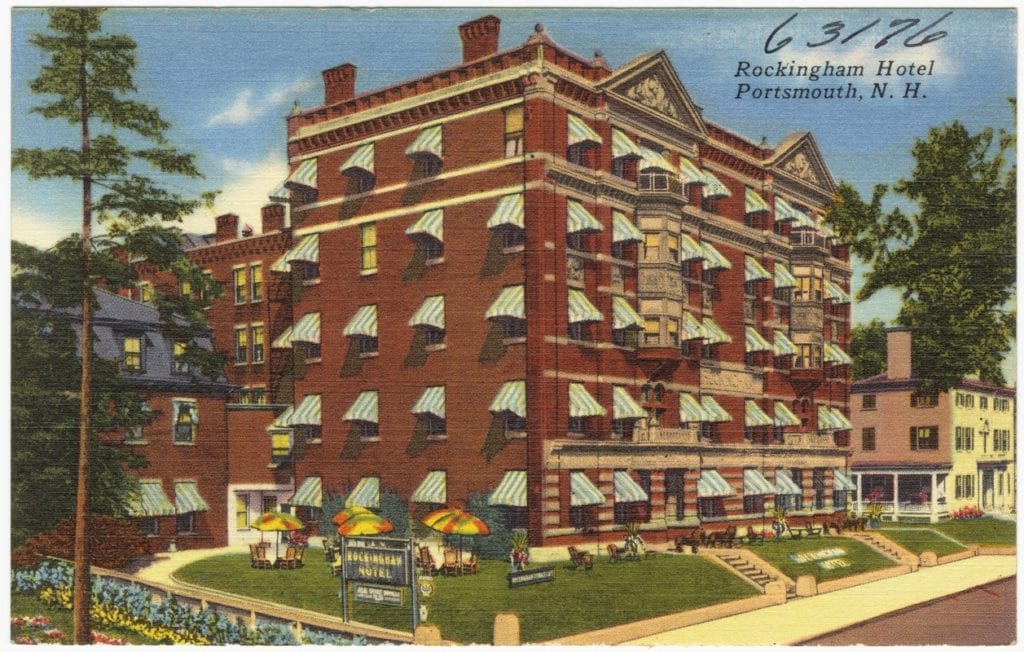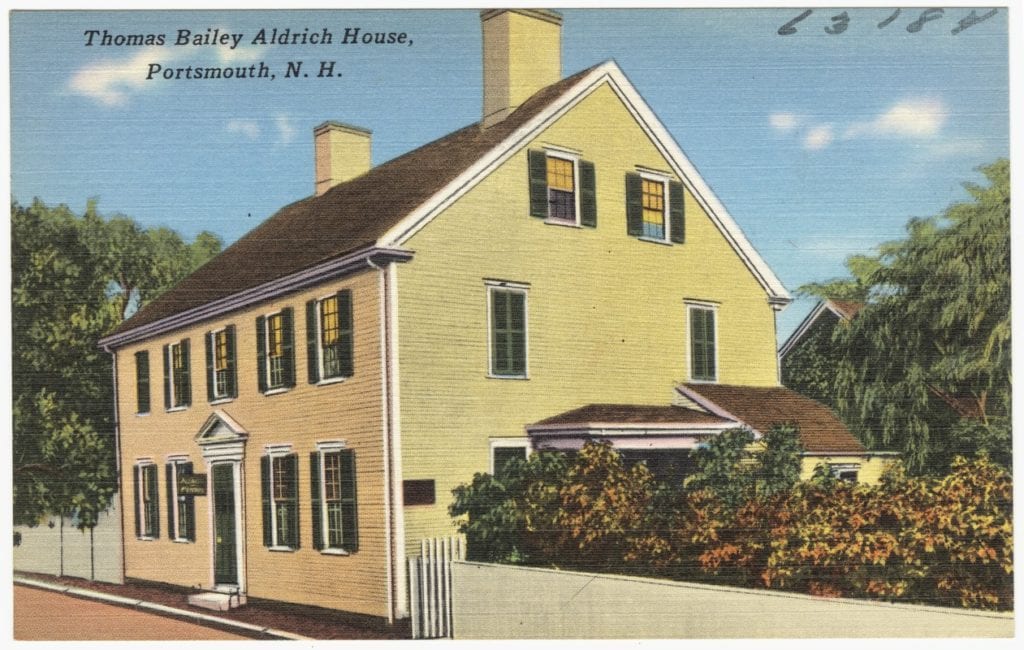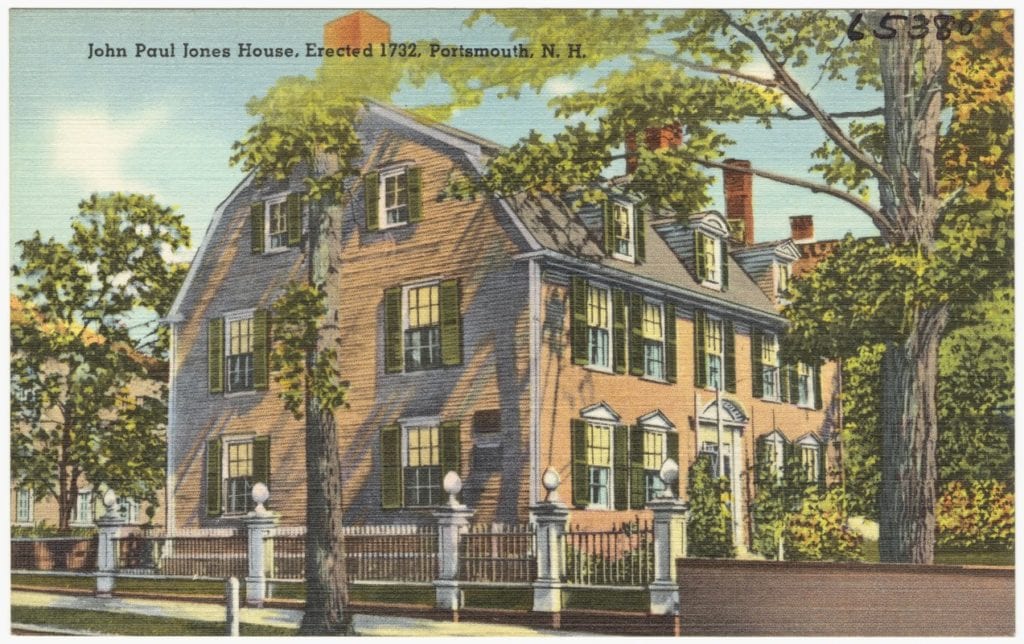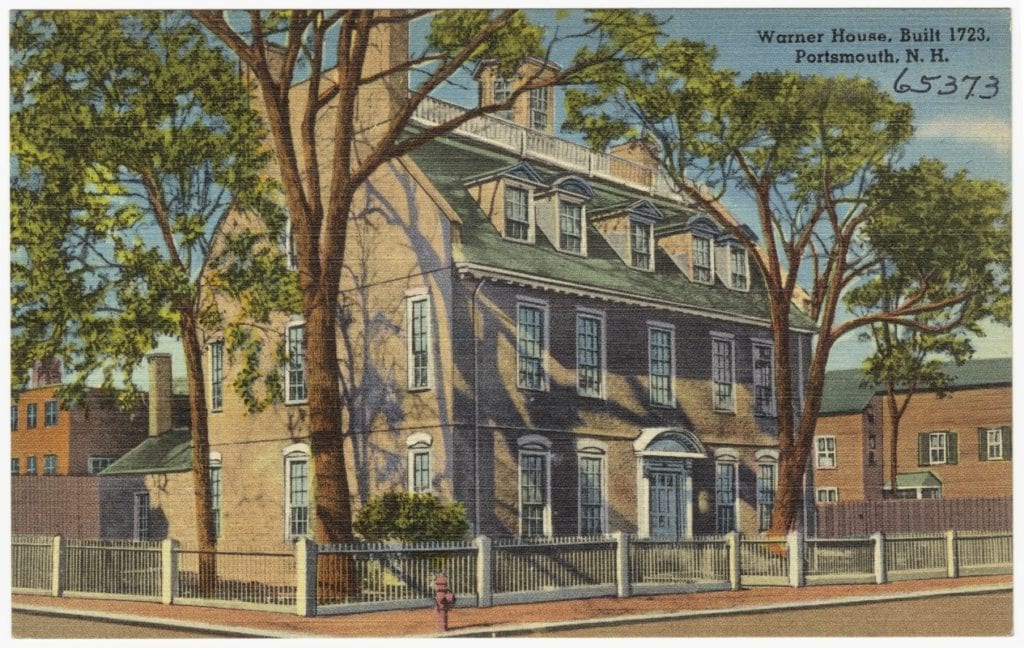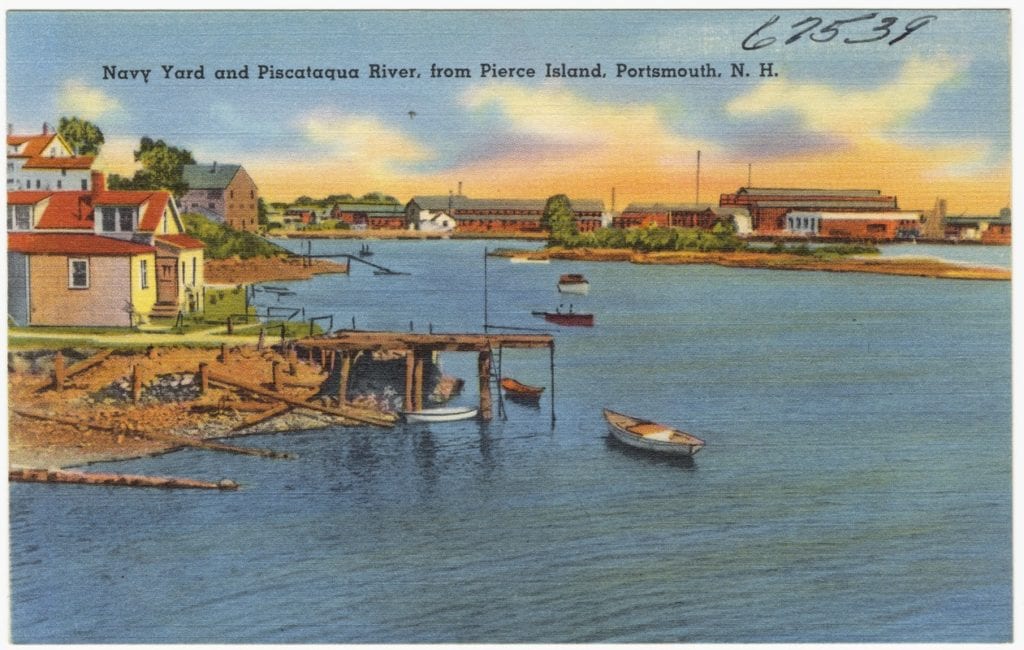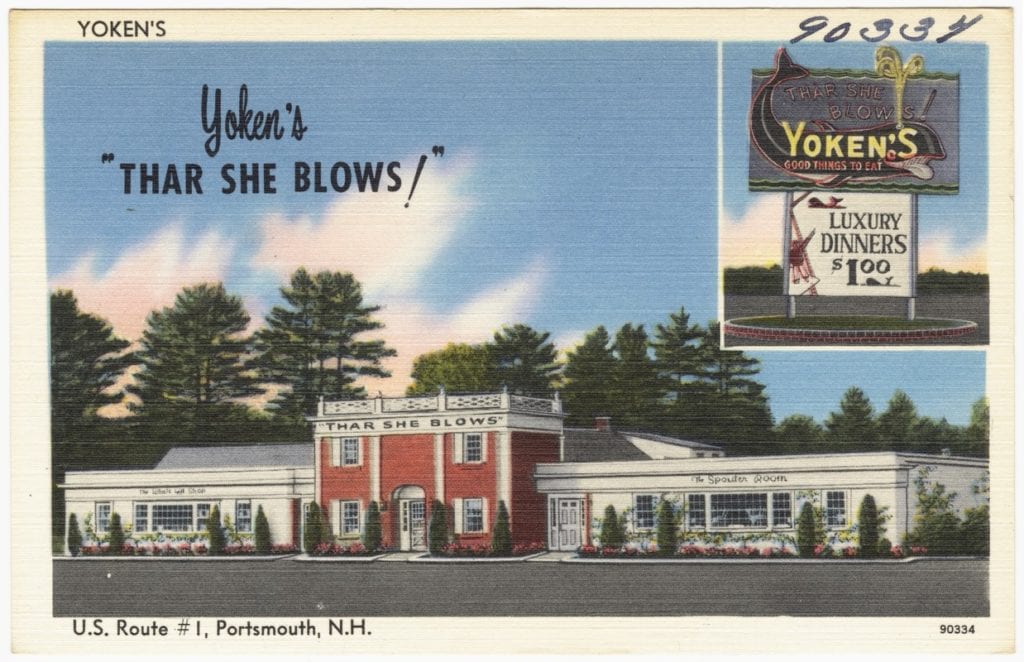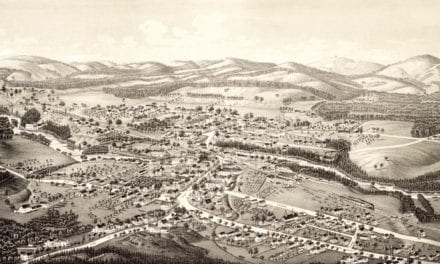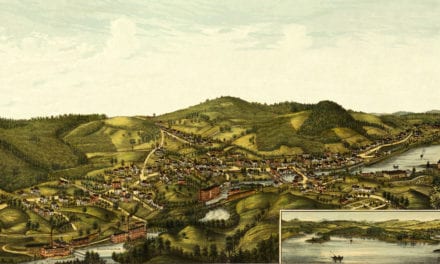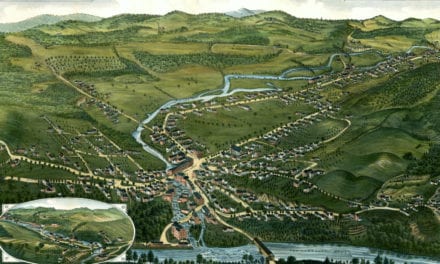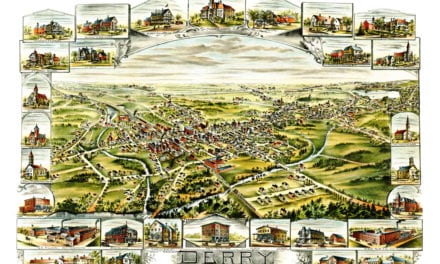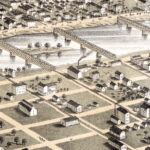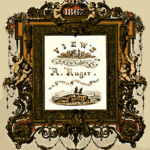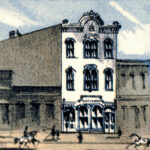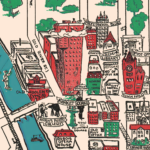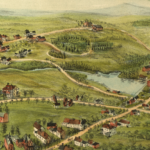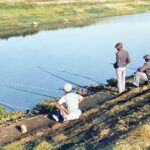Portsmouth, New Hampshire is a historic seaport, popular summer tourist destination, and home to 20,000+ proud residents. The first known European to explore and write about Portsmouth was Martin Pring in 1603, but Native Americans inhabited the area for thousands of years before Europeans arrived.
These images show Portsmouth, New Hampshire and the surrounding area as it looked in the 1940’s and 1950’s.
Aerial view of Wentworth By-the-Sea and Navy Yard
When Portsmouth was incorporated in 1653, it was named in honor of the colony’s founder, John Mason. He was the Captain of the port of Portsmouth, England, in Hampshire, the county in England for which New Hampshire is named.
Dry Dock, Navy Yard, Portsmouth, N.H.
The Portsmouth Navy Yard is a United States Navy shipyard on the southern boundary of Maine near the city of Portsmouth. The boundary of the dockyard is disputed, but it is legally considered to be part of Kittery, Maine. The city of Portsmouth claims the shipyard as its own, taking the case to the Supreme Court in 2001 in an attempt to officially have the land declared as part of New Hampshire, but the case was dismissed.
During World War I, the shipyard began constructing submarines, with the USS L-8 being the first ever built by a U.S. navy yard. Throughout World War I & II, the Portsmouth Dry Dock was used to overhaul and repair ships, with the workforce growing from 5,000 to almost 25,000 civilians during that time.
In World War II, more than 70 submarines were constructed at the yard, setting a record by launching four submarines in a single day. When the war ended, the shipyard became the Navy’s center for submarine design and development. Today it provides overhaul, refueling, and modernization work.
Wentworth By-the-Sea, Portsmouth, N.H.
Wentworth by the Sea (formerly The Hotel Wentworth) is a historic grand hotel. It is one of a handful of the state’s surviving Gilded Age grand hotels, and the last located on the seacoast.
Wentworth By-the-Sea, Portsmouth, N.H.
In 1905, the hotel housed the Russian and Japanese delegations who concluded the Treaty of Portsmouth to end the Russo-Japanese War. U.S. President Theodore Roosevelt suggested the peace talks, and won the Nobel Peace Prize for his actions.
Wentworth By-the-Sea, Portsmouth, N.H.
The hotel is now run by Marriott, with its full name being “Wentworth by the Sea, A Marriott Hotel & Spa”.
Toll gate and approach to Interstate Bridge
The Sarah Mildred Long Bridge was the second bridge able to carry motor vehicle traffic between Maine and New Hampshire via Portsmouth. The bridge replaced a river crossing that originally opened in 1822.
For many years, the bridge was simply known as the Maine-New Hampshire (Interstate) Bridge. In 1987, the bridge was renamed to honor Sarah M. Long, who had been an employee of the Maine-New Hampshire Interstate Bridge Authority for 50 years.
Due to its location in Portsmouth Harbor between the Memorial Bridge and the Piscataqua River Bridge, the Sarah Mildred Long Bridge is sometimes simply referred to as “the middle bridge” or “the old toll bridge”. It has also been called the “Dime Bridge”, in reference to the amount paid when it was a toll bridge.
Approaching the Sarah Mildred Long Bridge
This image shows the approach to the Sarah Mildred Long Bridge, which featured two separate movable portions. One section raised the railroad tracks below the road, allowing recreational boats to pass without disrupting traffic. The second section included the roadway itself, causing traffic to stop while larger boats passed beneath.
The bridge closed in August 2016. Its replacement is scheduled to open in September 2017.
Bridge passing under the Sarah M Long Bridge
This picture shows how the bridge would raise to allow large boats to pass underneath. A railroad track ran underneath the roadway of the bridge. At the time of its construction, the bridge cost $3,000,000.
View along Pescataqua River, Portsmouth, N.H.
The Piscataqua River is a 12-mile-long tidal river forming the boundary of the U.S. states of New Hampshire and Maine. After the Allies’ European victory in the Second World War, a German submarine flying a white flag sailed up the river, where New Hampshire state police received its captain and crew as POWs.
Memorial Bridge between Kittery and Portsmouth
The World War I Memorial Bridge is a vertical-lift bridge that carries U.S. Route 1 across the Piscataqua River between Portsmouth and Badger’s Island in Kittery, Maine. A large overhead plaque facing traffic on the bridge reads “Memorial to the Sailors and Soldiers of New Hampshire who gave their lives in the World War 1917–1919.”
The bridge opened in 1923, when five year old Eileen Foley cut the ceremonial silk ribbon to officially open the bridge. 45 years later, she became the mayor of Portsmouth and served eight terms. In August 2013, she returned to dedicate the bridge’s replacement 90 years later. These images show the original bridge, which existed from 1923 – 2012. A replacement bridge opened in 2013.
Memorial Bridge Raised for Boat
The lift span of the bridge can be fully opened to allow large commercial vessels to pass. During summer, the lift section remains partially elevated every half-hour between 7 a.m. and 7 p.m. for about 15 minutes. This allows smaller commercial and recreational boat traffic.
Fort Constitution from the Harbor, Portsmouth, N.H.
Fort Constitution is a fort in Portsmouth that was originally called Fort William and Mary when it was under British control. After the British abandoned the fort during the American Revolution, the Patriots referred to it as Fort Hancock, Fort Castle, Castle Fort, and eventually, in 1808, it became Fort Constitution.
U.S. Naval Prison, Portsmouth Navy Yard
Portsmouth Naval Prison is a former U.S. Navy and Marine Corps prison on the grounds of the Portsmouth Naval Shipyard. It was constructed between 1905 and 1908. The building has the appearance of a castle, and was known as the “Alcatraz of the East”, because it was modeled after Alcatraz’s design and was built on an island surrounded by strong tidal currents to deter escape. The reinforced concrete naval prison was occupied from 1908 until 1974.
Portsmouth Naval Prison
This view shows the Naval Prison after it was expanded. Two wings were added to the original prison. In 1942 the northeast wing was added, and in 1943 the unornamented southwest wing, dubbed “the Fortress,” which rises sheer beside the rocky shore. Maximum occupancy reached 3,088 in 1945.
Whaleback Light, Portsmouth, N.H.
Whaleback Light is a historic lighthouse marking the mouth of the Piscataqua River between New Castle, New Hampshire and Kittery, Maine. It is located on a rocky outcrop offshore southwest of Fort Foster and south of Wood Island in Kittery. A light has been active at this location since 1820; the present tower was built in 1872.
General John Sullivan Memorial Bridge
The General Sullivan Bridge is a deck truss bridge, with a through truss span to accommodate ship traffic, that formerly carried the roads that now travel over the Little Bay Bridge. Completed in 1935, the bridge has been closed to vehicle traffic since the opening of the second Little Bay span in 1984.
The bridge was named for John Sullivan, a Revolutionary War general, Governor of New Hampshire, and delegate to the Continental Congress, who was from nearby Somersworth. Since being closed to vehicular traffic, the General Sullivan has been used by pedestrians and cyclists, as the Little Bay Bridge does not have facilities for foot traffic. The older bridge is also a popular fishing spot.
Junior High School and Mill Pond
The Portsmouth Middle School first opened to students on Sept. 14, 1931. The school cost $384,000 to build and furnish. The enrollment on that first day in 1931 was 631, with students in Grades 7-9. According to SeaCoastOnline, most of the children used to walk home to eat lunch each day. The cafeteria only had seats for the 100 who didn’t.
Congress Street, Portsmouth, N.H.
This image shows Congress St as it looked in the 1950’s.
Portsmouth Floral Co., Inc., Portsmouth, N.H.
Portsmouth Floral Co. was a flower shop that served the Portsmouth community.
Hospital and Nurses Home
In 1884, citizens of Portsmouth, NH, came together to found Cottage Hospital, a 10-bed acute care facility located on Court Street and now known as The Aldrich House. The very next year, the new Portsmouth Hospital was built on Junkins Avenue near Mill Pond and served the area for more than a century, expanding and diversifying to meet the community’s healthcare needs.
Naval Hospital, Portsmouth, N.H.
The naval hospital is the U.S. Navy’s oldest, continuously operating hospital. The hospital has been open since 1830, serving past and present military members and their families.
Ham’s New Location, Route 1, Lafayette Road
Charles W. Ham, of Portsmouth, N. H., was the proprietor of Ham’s Restaurant and Cafe on High Street. During its time, Ham’s Restaurant was one of the foremost restaurants of New England.The restaurant was famous in the 1900’s for the quality of its food, and the freshness of its vegetables (which came directly from Mr. Ham’s own garden truck).
Catholic Church, Portsmouth, N.H.
North Church, Portsmouth, N.H.
St. John’s Episcopal Church, Built 1807
Old Jackson House, Oldest House in Portsmouth
Pierce Mansion, Erected 1799
Rockingham Hotel, Portsmouth, N.H.
Thomas Bailey Aldrich House
The Thomas Bailey Aldrich House was built in 1797, but is most well known for being a childhood home of Thomas Bailey Aldrich. Aldrich grew up to become a revered American writer, poet, critic, and editor notable for his long editorship of The Atlantic Monthly. In 2000, the home was restored to look as it did in 1850.
John Paul Jones House, Erected 1732
The John Paul Jones House is a historic house at 43 Middle Street in Portsmouth, New Hampshire. The house now serves as a historic house museum and a National Historic Landmark. It is significant because it is the only known surviving structure in the United States associated with American Revolutionary War naval hero John Paul Jones, who lived in the building from 1781-82 when it was operated as a boarding house.
Warner House, Built 1716
The Warner House is the oldest, urban brick house in northern New England. The house was built in 1716, and is one of the finest early-Georgian brick houses in New England. It was declared a National Historic Landmark in 1960, and is listed on the National Register of Historic Places.
Navy Yard and Piscataqua River from Pierce Island
Peirce Island is a 27 acre island owned by the city of Portsmouth. The island separates the Piscataqua River from the “South End” of portsmouth. The island now has a variety of activities for locals and tourists to enjoy, including walking trails, fishing, swimming, and picnic areas.
Yoken’s “Thar She Blows!”, U.S. Route #1
Yoken’s was an iconic seafood restaurant in Portsmouth. It closed in 2004, but the sign remains in Portsmouth as a nod to the city’s past. In 2015, the sign was refurbished and still proudly hangs on Lafayette Road.
Share with your friends using the buttons below!

